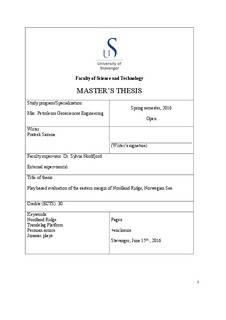| dc.contributor.author | Saxena, Prateek | |
| dc.date.accessioned | 2016-10-12T13:59:40Z | |
| dc.date.available | 2016-10-12T13:59:40Z | |
| dc.date.issued | 2016-06-15 | |
| dc.identifier.uri | http://hdl.handle.net/11250/2414756 | |
| dc.description | Master's thesis in Petroleum geosciences engineering | nb_NO |
| dc.description.abstract | The main objective of this study is produce a petroleum system evaluation of potential plays along the eastern margin of the Nordland Ridge. The area of study consists of two major tectonic structures; the Nordland Ridge and the Trøndelag Platform to its east. Significant discoveries along the western flank of Nordland Ridge have generated interest in furthering exploration of the central and eastern parts. The tectonic evolution of both, the Nordland Ridge and Trøndelag Platform began during the Permo-Carboniferous rifting episode but on Nordland Ridge, it has been overprinted by the subsequent mid Jurassic to mid Cretaceous tectonic activity. During this time the region was influenced by three distinct crustal extensions and a compressional phase resulting in a complex tectonic history. It was subaerially exposed which caused erosion of almost all of Cretaceous and some Jurassic strata from the uplifted highs and footwall crests. Upper Cretaceous and Paleogene deposits are quite thin with major hiatuses due to sea level variations.
Previous studies reveal that the Paleocene and Cretaceous sediments are thin and high in clay content. The Upper Jurassic contains oil prone organic rich but immature shales on the Trondelag Platform. Middle and Lower Jurassic sandstone units are also found on Trondelag Platform but are absent in parts on the Nordland Ridge due to erosion. The earliest deposits of these Lower Jurassic units are interbedded with coal layers which are also immature on the Trondelag Platform. The late Triassic deposits have good sand content and they overlie thick late Upper-Middle Triassic evaporites. Late Permian, has shown east Greenland equivalent carbonate buildup and organic rich shale deposits that have a good source rock potential. The primary targets have been defined as the Lower- Middle Jurassic sandstone units while Permian shales have been proposed as a notional source rock. Due to complex tectonic history, trap formation and retention is a risk for any petroleum system in the area. In addition to significant uncertainty tied to retention, one of the major geological risks is the migration of charge from the Trondelag Platform to the traps within the Nordland Ridge. | nb_NO |
| dc.language.iso | eng | nb_NO |
| dc.publisher | University of Stavanger, Norway | nb_NO |
| dc.relation.ispartofseries | Masteroppgave/UIS-TN-IPT/2016; | |
| dc.rights | Navngivelse 3.0 Norge | * |
| dc.rights.uri | http://creativecommons.org/licenses/by/3.0/no/ | * |
| dc.subject | petroleumsteknologi | nb_NO |
| dc.subject | petroleumsgeologi | nb_NO |
| dc.subject | petroleum geosciences engineering | nb_NO |
| dc.subject | Jurassic plays | nb_NO |
| dc.title | Play based evaluation of the eastern margin of Nordland Ridge, Norwegian Sea. | nb_NO |
| dc.type | Master thesis | nb_NO |
| dc.subject.nsi | VDP::Technology: 500::Rock and petroleum disciplines: 510::Geological engineering: 513 | nb_NO |

